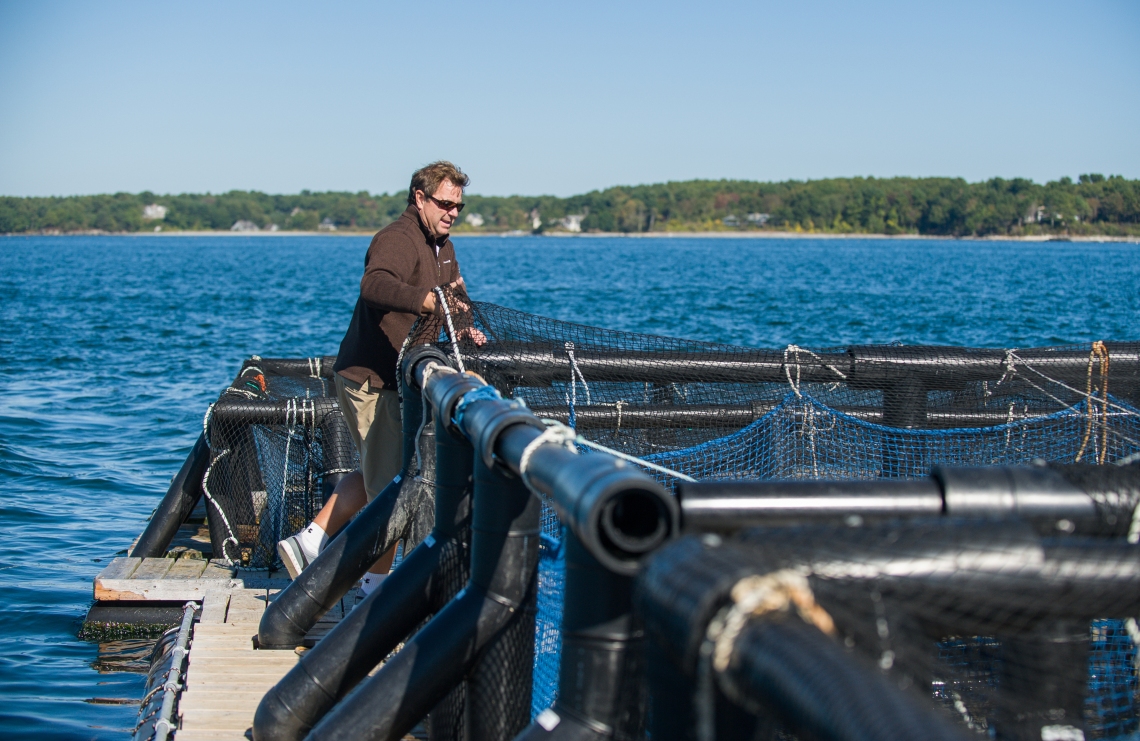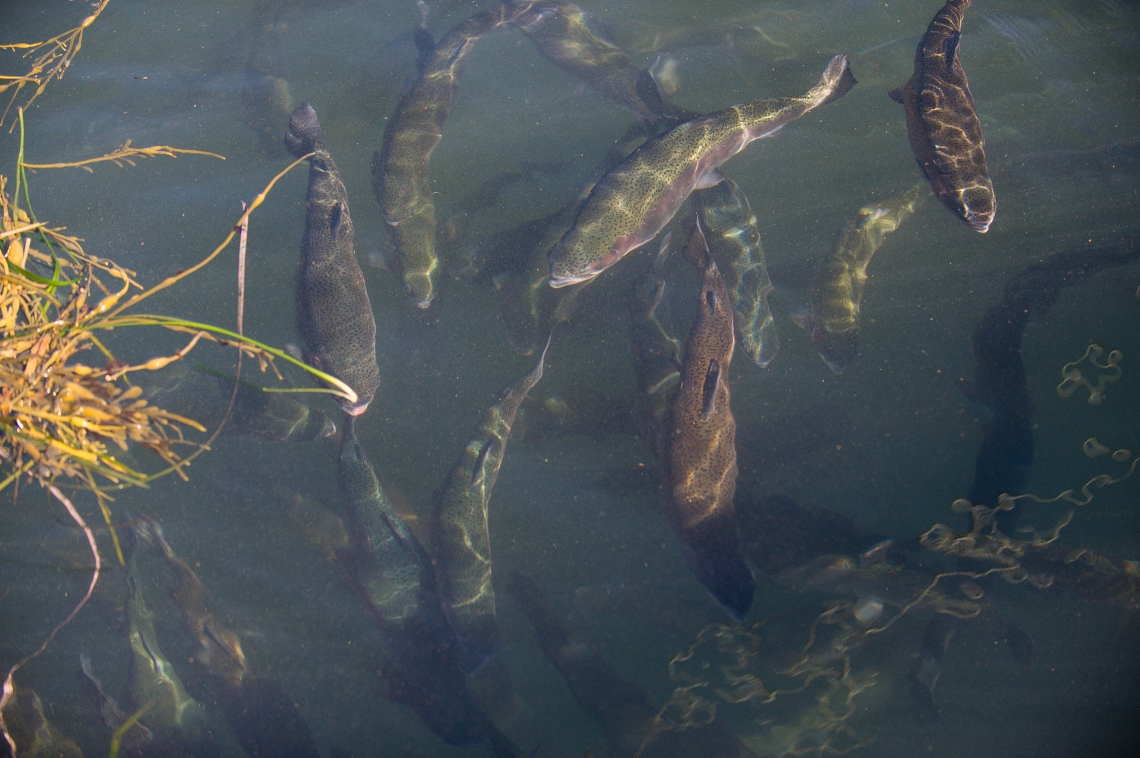An aggressive splashing comes from the water near the mouth of New Hampshire’s Piscataqua River, as dozens of fish jump above the surface. They all seemingly fly above the water. Their plump silver bodies glisten as the sun reflects off their green scales. There is no predator beneath them on attack. The fish, homegrown steelhead trout, are just hungry and fighting for their chance to eat.
That’s a good thing, as far as scientist Michael Chambers is concerned. The bigger these fish get, the better. Chambers is a research scientist at the University of New Hampshire and works with UNH Cooperative Extension and N.H. Sea Grant. One of his new and ongoing projects is called Integrated Multi-Trophic Aquaculture, referred to as IMTA. Chamber has been experimenting with the steelhead trout for five years. The fish are hatched in Ossipee, New Hampshire and sold to local markets before entering their main growing spot at the mouth of the Piscataqua river.

The website Aquaculture in Canada described integrated aquaculture as “the farming of different aquaculture species together in a way that allows one species’ wastes to be recycled as feed for another.”
Marine environments could potentially be cleaner by reduction of other organisms’ waste. Fishermen combine aquacultures that “require external feeding with species capable of deriving nutrients from wastes of the ‘fed’ species”. In other words, one organisms’ waste is another’s food.
Originally, Chambers’s project was seen as a kind of response to climate change. As global temperatures rise, and waters warm, disrupting natural ocean fisheries, the steelhead trout project offered predictability and control. But already Chambers is having to respond to that changing climate: warmer water is forcing him to move his beds deeper into the mouth of the Piscataqua, and the ultimate impact remains unclear.
The three organisms involved with Chambers’ IMTA project are Sugar Kelp, Steelhead Trout, and Blue Mussels. The three work together as their nutrients balance each other out.
“There is a three- to one-ton ratio of trout to sugar kelp, which help balance the nutrients in the water,” Chambers said. “Once harvested nitrogen is removed from the ecosystem.”
The trout excrete ammonia and phosphorus which are essential for the kelp. Any food that isn’t consumed by the trout along with other organic waste matter provides food for the mussels.
Another benefit of IMTA is that it could possibly reduce eutrophication, when water becomes oxygen-depleted and aquatic life dies. Eutrophication usually occurs if there are excessive nutrients added to the water.
The variety of organisms present in IMTA are beneficial to farmers as it gives them more crop to tend and sell. There are usually around four fishermen working at a specific site or location at a time.
Chamber’s has worked closely with fishermen to raise these trout.
“What people are mostly drawn to is the fact that it’s raised in New Hampshire as opposed to a trout or salmon from Norway, or Iceland, or Chile,” explained Chambers.

If there is ever a decline in fish from those countries, this provides an opportunity to be less dependent on imported goods. These fish have the potential to help anyone who attempts to make the food that they consume more locally sourced.
There are two hatcheries where the fish are artificially bred and hatched in Ossippee, New Hampshire. The females, also known as diploid fish, grow faster than the males, and the trout that are grown and harvested are mostly females. They are raised at the hatcheries and then transported to the mouth of the Piscataqua River in Portsmouth, New Hampshire.
The fish survive in fresh and salt water.
“Not too many fish can go from fresh water to salt water. Only about ten to fifteen percent of all fish have that ability,” said Chambers.
The fish are hatched in fresh water and transported to salt water. They hatch in spring and are harvested in mid-November.
“The females go from a quarter of a pound to about eight pounds in a five- to six-month growing period,” said Chambers. “Not too many fish can grow that fast in a seven-month period. From a marketing and sales standpoint, that is a great selling point for these trout.”
There are several IMTA experiments going on globally. In a report titled Can Integrated Multi-Trophic Aquaculture Adapt to Climate Change in Coastal Bangladesh, by researchers Nesar Ahmed and Marion Glaser, IMTA was described as “an ecosystem approach adaptation strategy to climate change.” The report also stated that IMTA can increase O2 production via photosynthesis of seaweeds by explaining that, “dissolved O2 from seaweeds may help increase microbial activities within the sediments, which in turn allow nutrients to be efficiently recycled from dead organisms.”
IMTA can also reduce CO2 emissions. A report called Integrated Multi-Trophic Aquaculture (IMTA) in Sanggou Bay, China found that IMTA has been used for more than a decade. The Sanggou Bay is in the eastern part of Shangdong province. The Sanggou report detailed how “fish produce waste in the form of uneaten feed, which induces the release of greenhouse gases into the atmosphere. Fish farming in combination with seaweed culture can turn the system into a CO2 sink through photosynthesis and uptake of nutrients.”
That being said, if IMTA worked correctly it could have significant potential on reducing CO2 emissions which could ultimately help in efforts to help climate change.
The real question is whether or not IMTA will be able to adapt to the warming waters due to climate change. The report from Ahmed and Glaser claim that “IMTA can adapt to changes in water salinity and increased water temperature due to filtration of waste particulate by shellfish and seaweeds. Seaweeds in IMTA can help keep water cool due to absorption of pollutants, sediments, and toxic substances.”
As shown by the example in Bangladesh, IMTA can be a possible adaptation to climate change, but it can also be affected by it as well.
The report Ocean Acidification and Marine aquaculture in North America: Potential Impacts and Mitigation Strategies, done by research scientists Jeff Clements and Thierry Chopin, cites multiple ecological and economic benefits concerning IMTA. “Its applications to mitigating the impacts of oceanic climate change have yet to be understood. Theoretically, IMTA cold contribute to mitigating ocean acidification,” the report said.
In an interview done by email, Chopin said, “IMTA could be an economic risk mitigation and management option to address pending climate change impacts.”
Chopin doesn’t see a huge problem with warmer temperatures and climate change when it comes to IMTA.
“Climate change will have an impact on the species selected, but that is not peculiar to IMTA, but all systems dealing with the cultivation of live organisms,” he said. “By cultivating several species, IMTA reduces economic risks. I think IMTA can be very flexible and adaptable.”
Chamber’s project in the Piscataqua already makes fishermen a nice profit in its fifth year. These trout are in high demand and each fish is already sold before going into the water at the Piscataqua.
“It takes about seven or eight cents a pound for us to raise these fish, and the fisherman charge about $6.50 per pound,” said Chambers. “Then the stores and markets can flip it and sell these trout for about $15 per pound.”
In local restaurants, a steelhead fish entree can cost between $15 and $25. The fishermen have a partnership with the company Seaport and Saunders to sell and distribute the fish to restaurants and local markets. From there the trout grace the plates of many popular restaurants, including the Black Trumpet in the Portsmouth area.
In a video made by the University of New Hampshire, Rich Pettigrew owner of Seaport Fish said, “the way the seafood industry is going, aquaculture is going to be the main stay for fish if we want to keep eating it. It gives the fisherman another outlet for locally raised products.”
IMTA and the fishermen’s partnership with local markets and restaurants will help continue the idea of local sustainability.
Research by Chambers has shown that temperatures have been rising.
“This year was the highest temps on record for us since 2010. Up from 18-22 C during the summer,” said Chambers.
It’s unclear if this will continue at the same rate, but if it does the project site will have to be moved.
“I don’t know if this is a pattern but we will see next year. If this continues, will have to move offshore to deeper waters where we can lower the fish net into the thermocline (four to eight meters below surface),” said Chambers. “Here it is typically three to four degrees celcius lower than surface temp.”
If water temperatures continue to rise, Chambers believes that there will need to be some changes and adaptions made to his project.
“It [climate change] is absolutely related,” Chambers said. “Temperatures are increasing at our current site. This is affecting the growth and survival of the trout, kelp and mussels. As a result, we will have to move the IMTA operations further offshore into deeper waters. Here, we can drop the net and lines down deeper into the thermocline where temps are 5-8 C cooler in the summer and early fall.”
The move will happen next fall if temperatures are still too high for the fish.

